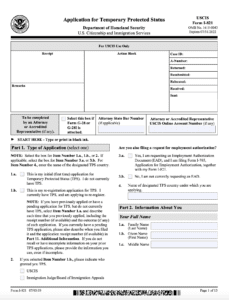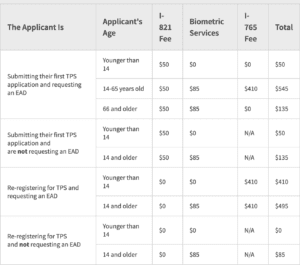TPS Requirements & Eligibility Complete Guide 2022
Ukraine and Sudan are the two most recent countries to receive Temporary Protected Status (TPS) from the United States Department of Homeland Security (DHS) due to the unsafe living conditions from the war with Russia and political unrest in Sudan. There are about 59,600 individuals from Ukraine in the U.S. who may be eligible for TPS, and approximately 3,090 individuals are eligible for TPS under the designation of Sudan. Discover TPS requirements, eligibility, how to file a TPS application, and more.
What is Temporary Protected Status?
DHS created TPS as a designation for foreign nationals who face conditions in their home country that prevent them from returning safely. DHS considered the following factors for TPS eligibility:
- Eligible residents of certain countries (or parts of countries) who are already in the United States; and
- Qualified individuals without nationality who last resided in the designated country.
TPS safeguards individuals from U.S. removal. In addition, TPS holders can apply for an employment authorization to legally work, and they are eligible for a travel document to travel overseas. According to the American Immigration Council, there were approximately 319,465 people with Temporary Protected Status and another 480,000+ people eligible for TPS as of last year.
Reason A Country May Be Designated TPS
To qualify for Temporary Protected Status, a country must meet the following conditions:
- Environmental disasters such as a hurricane, earthquake, epidemic, or other natural occurrences that severely affects the habitability of the area
- War or armed conflict
- Extraordinary and temporary conditions, which could be any issue that the U.S. deems temporary and also not safe for a foreign national to return to (except if the U.S. government finds that it poses a threat to national security for the foreign nationals to remain in the U.S.)
TPS Requirement
To be eligible for Temporary Protected Status, you must meet the following eligibility:
- You are a national of a country that has been designated with temporary protected status or are someone who does not have a nationality but last resided in that country.
- File timely during the registration or re-registration period. You should meet the requirements if you file during the late filing period.
- You have been physically present in the U.S. continuously since the effective date of the most recent designation date of the TPS.
- Have lived continuously in the U.S. since the required date for your country’s TPS. DHS permits brief departures from the U.S. under this law.
Inadmissibility for TPS
DHS may find you ineligible for protected status based on the TPS requirements if any of the following are true:
- Convicted of a felony or two or more misdemeanors in the United States
- You are inadmissible as an immigrant under INA section 212(a)
- DHS bars asylum due to participating in terrorist activity, the persecution of someone else, etc. See a complete list of USCIS asylum bars here.
- Have not met the continuous physical presence requirement
- Did not file during the initial or late TPS registration period
Filing for Temporary Protected Status
The first step is to read all the instructions on Form I-821, Application for Temporary Protected Status. After that, you can file it entirely online and as a side note, you can also request an Employment Authorization Document at the same time by filing Form I-765, Application for Employment Authorization, alongside Form I-821.
Part 1. Type of Application
The first part of Form I-821 has you select the type of application you are filing. For example, if this is your first application for TPS and you do not currently have it, select 1.a. If this is your re-registration application for TPS, select 1.b.
Suppose you checked 1.b., then in line 2 select the agency that gave you protected status (USCIS or an Immigration Judge/Board of Immigration Appeals).
If you are also requesting Employment Authorization, check box 3.a.
Part 2. Information About You
In this section, you will provide your full name, U.S. mailing address, U.S. physical address, date of birth, marital information, U.S. entry information (date of last entry, location, travel document information, etc.) and your current immigration status or lack of status.
Part 3. Biographic Information
Indicate your ethnicity, race, height, weight, eyes, and hair color in this section.
Part 4. Information About Your Current Spouse (if any)
Only complete this section if you are filing a late initial application for TPS and you have a current spouse.
In line 1, put your spouse’s USCIS account number (if any). Line 2 is for their A-Number (if any). Write their full name, spouse’s mailing address, spouse’s date of birth, date of your marriage, and place of marriage. Finally, in line 9, check yes or no if they have ever had TPS. If they have, include the dates of their status.
Part 5. Information About Your Former Spouses (if any)
Only complete this section if you are filing a late initial application for TPS.
Include the names of all your former spouses in this section.
Part 6. Information About Your Children (if any)
Only complete this section if you are filing a late initial application for TPS and have children.
Part 7. Eligibility Standards
The following section asks you a series of questions related to your TPS eligibility. Some questions relate to criminal activity in your past, your immigration history, and whether you have ever been detained. Answer yes or no honestly to all of these questions.
Part 8. Applicant’s Statement, Contact Information, Certification, and Signature
In this section, you certify that you can read and understand English and have understood and answered all questions on the form accurately. If you used an interpreter, continue on to Part 9.
Part 9 & 10. Interpreter’s Contact Information, Certification and Signature/ Contact Information, Declaration, and Signature of the Person Preparing this Application, if Other than the Applicant
These two sections are strictly if an interpreter or someone other than the applicant prepares the application
Part 11. Additional Information
This section is provided to provide additional room if necessary to answer any questions.
Filing Fee
The filing fee will vary depending on who the applicant is. For example, if the applicant is submitting their first TPS application and requesting an EAD and is 14-65 years old, the I-821 fee is $50, the biometric service fee would be $85 and the I-765 fee would be $410 for a grand total of $545. Check the chart below to see which category you fall into.
TPS Countries
Countries currently designated for Temporary Protected Status as of the date of this post are:
Frequently Asked Questions Regarding TPS Requirements
Are Ukrainian nationals living outside the U.S. eligible to apply for TPS?
No, they are currently not and would not become eligible by moving to the United States now.
How do I file for TPS as a Ukrainian?
During the 18-month initial registration period that runs from April 19, 2022, through October 19, 2023, you can apply for TPS by submitting Form I-821, Application for Temporary Protected Status. At the same time, applicants can request an Employment Authorization Document.
Who does not qualify based on the TPS requirements?
DHS will likely deny TPS status to individuals with a criminal record or criminal-related grounds of inadmissibility. You are also likely inadmissible if DHS bars you from asylum as a result of participating in terrorist activity or the persecution of another person. If you did not meet the continuous physical presence requirement or did not file during the initial or late TPS registration period, you could not qualify.
How long does it take for TPS to be approved?
It takes roughly six months for Form I-821 to be processed, and if you are seeking an Employment Authorization Document, that takes about three months. Consult your immigration attorney for the most up-to-date processing times.
Who gets TPS?
The countries currently designated with TPS status are Afghanistan, Burma, El Salvador, Haiti, Honduras, Nepal, Nicaragua, Somalia, Sudan, South Sudan, Syria, Ukraine, Venezuela, and Yemen. Click here to see the current and most up-to-date TPS countries.
Can I still apply for TPS?
Whether you can apply will depend on the filing period for your particular TPS designated country.
How can I check my TPS status?
You can check your TPS status by visiting the Case Status website.
Does getting TPS mean I will automatically get permanent residency?
Being granted TPS does not mean you get permanent residency. When the Secretary of Homeland Security determines the termination of your country’s TPS designation for your country, your immigration status will return to what it was before your TPS status. If that previous status was expired, you would need to return to your home country unless you obtain a different status. If your TPS status is extended, you need to re-register with USCIS for the period of time the TPS is extended. You can do so by filing Form I-821 (during the extension period).
What happens if I do not re-register?
If you fail to re-register, your Temporary Protected Status will be withdrawn.







